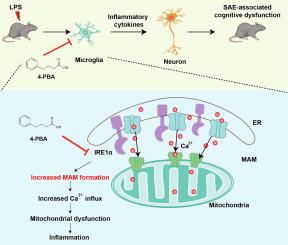当前位置:
X-MOL 学术
›
Exp. Neurol.
›
论文详情
Our official English website, www.x-mol.net, welcomes your feedback! (Note: you will need to create a separate account there.)
4-PBA exerts brain-protective effects against sepsis-associated encephalopathy in a mouse model of sepsis
Experimental Neurology ( IF 5.3 ) Pub Date : 2024-02-21 , DOI: 10.1016/j.expneurol.2024.114738 Feng Xiong , Cailin Wang , Jun Lu , Guangyang Bai , Daixing Zhou , Jianmin Ling
Experimental Neurology ( IF 5.3 ) Pub Date : 2024-02-21 , DOI: 10.1016/j.expneurol.2024.114738 Feng Xiong , Cailin Wang , Jun Lu , Guangyang Bai , Daixing Zhou , Jianmin Ling

|
Neuroinflammation assumes a pivotal role in both the etiological underpinnings and the dynamic progression of sepsis-associated encephalopathy (SAE). The occurrence of cognitive deficits with SAE is associated with neuroinflammation. 4-phenyl butyrate (4-PBA) may control inflammation by inhibiting endoplasmic reticulum stress (ERS). The primary objective of this investigation is to scrutinize the effectiveness of 4-PBA in mitigating neuroinflammation induced by lipopolysaccharides (LPS) and its consequent impact on cognitive function decline. LPS-injected mice with SAE and LPS-treated BV2 cell were established to serve as experimental paradigms, both contributing to the investigative framework of the study. Cognitive functions were assessed by behavioral tests. Hippocampal neuronal damage was assessed using Golgi staining and Nissl staining. Quantitative PCR assay and immunofluorescence were used to analyze neuroinflammation. Mitochondrial function was examined using transmission electron microscopy. Protein expression analysis was conducted through the application of western blotting methodology, serving as the investigative approach to elucidate molecular signatures in the experimental framework. Endoplasmic reticulum and mitochondrial calcium flow were detected using flow cytometry. To delve deeper into the mechanistic intricacies, the administration of 4μ8c was employed to selectively impede the IRE1α/Xbp1s pathway, constituting a strategic intervention aimed at elucidating underlying regulatory processes. Expression levels of ERS-related proteins exhibited a significant upregulation in hippocampal tissues of LPS-treated mice when compared to wild-type (WT) counterparts. The administration of 4-PBA notably ameliorated memory deficits in LPS-treated mice. Furthermore, 4-PBA treatment was found to alleviate oxidative stress and neuroinflammation. Mechanistically, the IRE1α/Xbp1s-Ca signaling pathway played a crucial role in mediating the beneficial effects of mitigating oxidative stress and maintaining mitochondrial calcium homeostasis, with inhibition of the IRE-related pathway displaying opposing effects. Our results suggest that administration of 4-PBA treatment significantly attenuates ERS, alleviates cognitive decline, reduces inflammatory damage, and restores mitochondrial dynamics via the IRE1α/Xbp1s-Ca-associated pathway, which provides a new potential therapeutic approach to SAE.
中文翻译:

4-PBA 在脓毒症小鼠模型中对脓毒症相关脑病发挥脑保护作用
神经炎症在脓毒症相关脑病(SAE)的病因学基础和动态进展中发挥着关键作用。 SAE 认知缺陷的发生与神经炎症有关。 4-苯基丁酸酯 (4-PBA) 可以通过抑制内质网应激 (ERS) 来控制炎症。本研究的主要目的是检查 4-PBA 在减轻脂多糖 (LPS) 诱导的神经炎症方面的有效性及其对认知功能下降的影响。注射 LPS 的 SAE 小鼠和 LPS 处理的 BV2 细胞被建立作为实验范例,两者都有助于该研究的研究框架。通过行为测试评估认知功能。使用高尔基染色和尼氏染色评估海马神经元损伤。定量PCR检测和免疫荧光用于分析神经炎症。使用透射电子显微镜检查线粒体功能。通过应用蛋白质印迹方法进行蛋白质表达分析,作为阐明实验框架中分子特征的研究方法。使用流式细胞术检测内质网和线粒体钙流。为了更深入地研究错综复杂的机制,使用 4μ8c 来选择性阻碍 IRE1α/Xbp1s 通路,构成旨在阐明潜在调控过程的战略干预。与野生型 (WT) 小鼠相比,LPS 处理小鼠海马组织中 ERS 相关蛋白的表达水平显着上调。 4-PBA 的施用显着改善了 LPS 治疗小鼠的记忆缺陷。此外,4-PBA 治疗被发现可以减轻氧化应激和神经炎症。从机制上讲,IRE1α/Xbp1s-Ca 信号通路在介导减轻氧化应激和维持线粒体钙稳态的有益作用中发挥着至关重要的作用,而抑制 IRE 相关通路则表现出相反的作用。我们的结果表明,4-PBA 治疗可显着减弱 ERS,减轻认知能力下降,减少炎症损伤,并通过 IRE1α/Xbp1s-Ca 相关途径恢复线粒体动力学,这为 SAE 提供了一种新的潜在治疗方法。
更新日期:2024-02-21
中文翻译:

4-PBA 在脓毒症小鼠模型中对脓毒症相关脑病发挥脑保护作用
神经炎症在脓毒症相关脑病(SAE)的病因学基础和动态进展中发挥着关键作用。 SAE 认知缺陷的发生与神经炎症有关。 4-苯基丁酸酯 (4-PBA) 可以通过抑制内质网应激 (ERS) 来控制炎症。本研究的主要目的是检查 4-PBA 在减轻脂多糖 (LPS) 诱导的神经炎症方面的有效性及其对认知功能下降的影响。注射 LPS 的 SAE 小鼠和 LPS 处理的 BV2 细胞被建立作为实验范例,两者都有助于该研究的研究框架。通过行为测试评估认知功能。使用高尔基染色和尼氏染色评估海马神经元损伤。定量PCR检测和免疫荧光用于分析神经炎症。使用透射电子显微镜检查线粒体功能。通过应用蛋白质印迹方法进行蛋白质表达分析,作为阐明实验框架中分子特征的研究方法。使用流式细胞术检测内质网和线粒体钙流。为了更深入地研究错综复杂的机制,使用 4μ8c 来选择性阻碍 IRE1α/Xbp1s 通路,构成旨在阐明潜在调控过程的战略干预。与野生型 (WT) 小鼠相比,LPS 处理小鼠海马组织中 ERS 相关蛋白的表达水平显着上调。 4-PBA 的施用显着改善了 LPS 治疗小鼠的记忆缺陷。此外,4-PBA 治疗被发现可以减轻氧化应激和神经炎症。从机制上讲,IRE1α/Xbp1s-Ca 信号通路在介导减轻氧化应激和维持线粒体钙稳态的有益作用中发挥着至关重要的作用,而抑制 IRE 相关通路则表现出相反的作用。我们的结果表明,4-PBA 治疗可显着减弱 ERS,减轻认知能力下降,减少炎症损伤,并通过 IRE1α/Xbp1s-Ca 相关途径恢复线粒体动力学,这为 SAE 提供了一种新的潜在治疗方法。



























 京公网安备 11010802027423号
京公网安备 11010802027423号